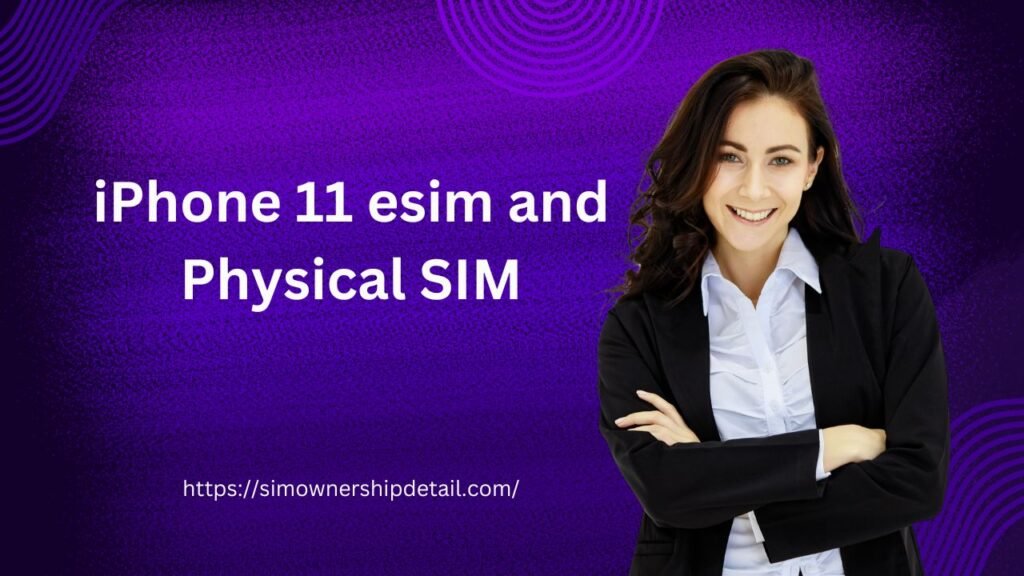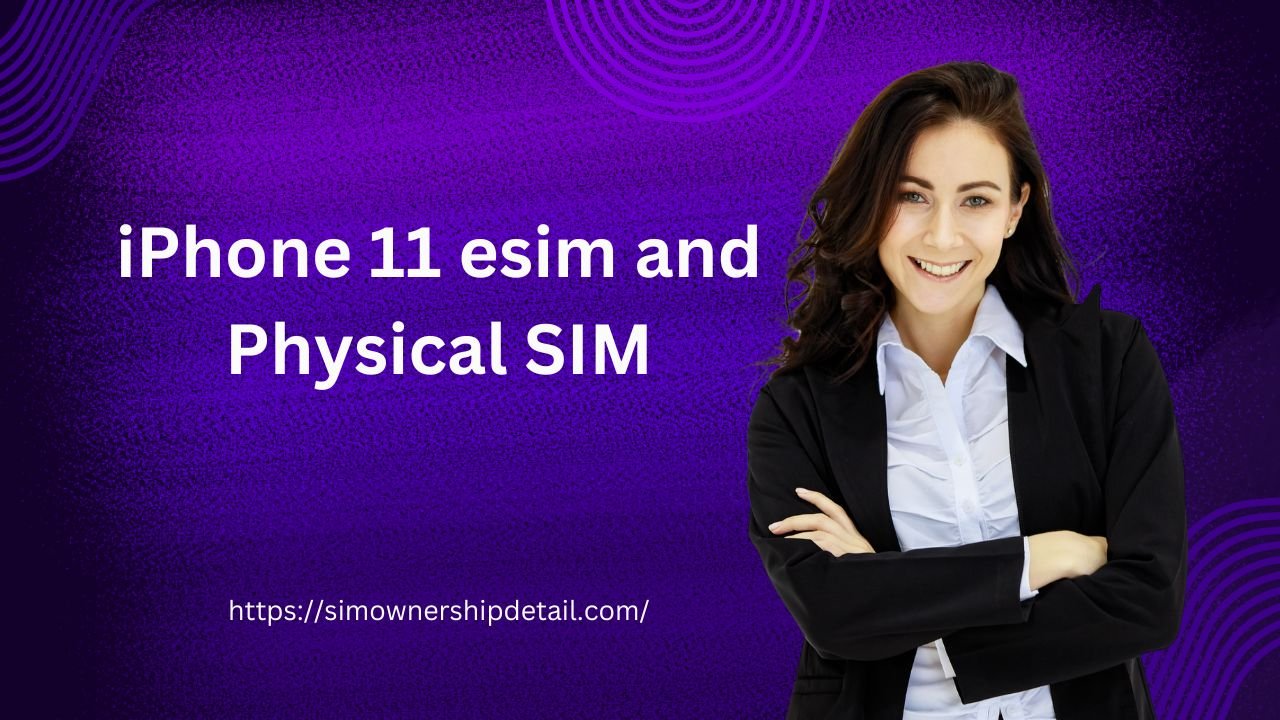In today’s tech-savvy world the eSIM technology has become a game-changer, offering unparalleled convenience and flexibility. If you’re an iPhone 11 owner or considering getting one understanding how eSIM works and its benefits is crucial. This comprehensive guide will walk you through everything you need to know about the iPhone 11 eSIM from setup to advantages and how it might transform your mobile experience.

What is an eSIM?
Before diving into the specifics of the iPhone 11 eSIM let’s clarify what an eSIM actually is. Unlike a traditional SIM card, which is a physical card that you insert into your phone, an eSIM (embedded SIM) is a digital SIM built into your device. It eliminates the need for a physical card and offers a range of benefits, including easier management of multiple phone numbers and more streamlined carrier switching.
How Does eSIM Work on the iPhone 11?
The iPhone 11 supports eSIM technology alongside a physical SIM card allowing you to use dual SIMs simultaneously. Here’s how it works:
- Digital Activation: You can activate an eSIM directly from your iPhone 11 settings without needing to visit a carrier store or wait for a physical SIM card.
- Dual SIM Functionality: With the iPhone 11 you can use both a physical SIM card and an eSIM which is perfect for managing personal and business numbers or when traveling internationally.
- Carrier Support: Not all carriers support eSIMs, so you’ll need to check with your carrier to ensure they offer this service. Most major carriers worldwide have adopted eSIM technology, but it’s always good to verify.
Key Differences: iPhone 11 eSIM vs. Physical SIM
- Installation and Setup
- Physical SIM: Requires you to insert a small card into a designated SIM tray on your iPhone 11. If you switch carriers or need a new SIM, you must replace the physical card.
- eSIM: Activated digitally through your iPhone’s settings. You receive an activation code or QR code from your carrier and can set up the eSIM without needing to handle any physical card.
- Convenience
- Physical SIM: Switching SIM cards can be cumbersome, especially when traveling or if you need to swap out SIMs frequently. It involves physically removing and inserting the SIM card.
- eSIM: Provides greater convenience with digital management. You can easily switch carriers or plans, and even add multiple eSIMs for different numbers or plans without dealing with physical cards.
- Dual SIM Capability
- Physical SIM: On the iPhone 11, you can use one physical SIM and one eSIM simultaneously, but if you only use a physical SIM, you’re limited to a single number.
- eSIM: Allows for dual SIM functionality, meaning you can use both a physical SIM and an eSIM concurrently. This setup is ideal for managing personal and business numbers or for international travel.
- Carrier Flexibility
- Physical SIM: Requires a physical SIM card from your carrier, which might limit flexibility if you frequently change carriers or travel abroad.
- eSIM: Provides more flexibility. You can switch carriers and plans digitally without needing to change physical SIM cards. This is particularly useful for frequent travelers who need to switch to local carriers quickly.
- Security
- Physical SIM: Physical SIM cards can be lost, stolen, or damaged, which may require replacement and can pose a security risk.
- eSIM: Offers a more secure option as it is embedded within the phone and cannot be removed or easily tampered with. This can reduce the risk of SIM theft or loss.
- Space Efficiency
- Physical SIM: Takes up physical space within your phone, which could be used for other components or features.
- eSIM: Frees up space within the device. The absence of a physical SIM tray can allow for a more compact and streamlined design.
- Cost
- Physical SIM: Generally inexpensive and may be provided at no extra cost by carriers.
- eSIM: May involve additional setup fees or require a plan upgrade, depending on your carrier. However, it often saves costs related to physical SIM replacements and international roaming.
Which Should You Choose?
- Opt for a Physical SIM if you prefer the traditional method, often find yourself switching phones frequently, or have a carrier that does not support eSIMs.
- Go for eSIM if you value convenience frequently travel internationally, or want to manage multiple numbers and plans digitally. The eSIM option is also ideal if you’re looking for a sleek, modern solution that minimizes physical card handling.
Setting Up eSIM on Your iPhone 11
Setting up an eSIM on your iPhone 11 is a straightforward process. Here’s a step-by-step guide:
- Check Compatibility: Make sure your carrier supports eSIM and that your iPhone 11 is updated to the latest iOS version.
- Get an eSIM Activation Code: Contact your carrier to get an eSIM activation code or QR code. This might be provided via email or a physical card.
- Add Cellular Plan:
- Open the iPhone 11’s Settings app.
- Tap Cellular or Mobile Data.
- Tap Add Cellular Plan.
- Scan the QR code or enter the details provided by your carrier.
- Label Your Plans: Once the eSIM is activated, you can label your plans (e.g., Personal, Business) to easily distinguish between them.
- Choose Default Lines: Set your default line for calls, messages, and data. You can switch between lines as needed.
Advantages of Using eSIM on the iPhone 11
Switching to eSIM on your iPhone 11 offers several compelling benefits:
- Convenience: No more fumbling with physical SIM cards. Everything is managed digitally, making it easier to switch carriers or plans.
- Travel-Friendly: When traveling, you can easily add a local eSIM plan without having to swap out physical SIM cards. This means less hassle and better connectivity abroad.
- Multiple Numbers: With dual SIM capability, you can manage both personal and work numbers from a single device, reducing the need for multiple phones.
- Space-Saving: Since the eSIM is embedded, it frees up physical space within your phone, potentially allowing for other advancements in design and technology.
Troubleshooting eSIM Issues
While eSIM technology is generally reliable, you might encounter occasional issues. Here are some common troubleshooting steps:
- Check Carrier Settings: Ensure your carrier settings are up-to-date. Go to Settings > General > About to check for updates.
- Restart Your iPhone: Sometimes a simple restart can resolve connectivity issues.
- Contact Your Carrier: If you’re experiencing persistent problems, your carrier’s customer support can offer specific solutions tailored to your situation.
Conclusion
The iPhone 11 eSIM feature is a fantastic addition bringing flexibility and convenience to your mobile experience. Whether you’re managing multiple numbers traveling internationally or simply enjoying the sleek design of your phone eSIM technology offers a modern solution to traditional SIM card limitations. By following the steps outlined in this guide you can easily set up and make the most of your iPhone 11 eSIM capabilities. You can also check sim owner details of any network.
Embrace the future of mobile connectivity with the iPhone 11 eSIM and experience a new level of convenience and efficiency.
